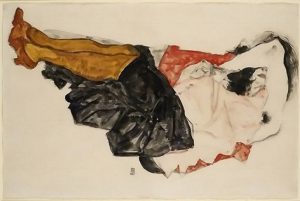Two Schiele paintings will be returned to the heirs of Fritz Grunbaum, a holocaust victim and broadway star of his time
NEW YORK, NY – Today, in a landmark decision by Justice Charles E. Ramos, the heirs of Holocaust victim Fritz Grunbaum were awarded title to two Nazi-looted artworks, Woman in a Black Pinafore and Woman Hiding her Face, by the artist Egon Schiele. The case, Reif vs. Nagy, has been winding its way through the courts since November 2015 when attorney Raymond Dowd requested the artworks be returned to Grunbaum’s heirs, including Timothy Reif, after they were discovered in Mr. Nagy’s booth at the Salon Art + Design Show at the Park Avenue Armory in New York City.
“This is an important victory in what is probably the most important art case of the late 20th century,” said Attorney Raymond Dowd, partner at Dunnington, Bartholow, & Miller LLP. “It is a victory for Holocaust victims, their families, and all those who fought and died to undo the evils of Nazism. This decision brought us a step closer to recovering all of the culture that was stolen during the largest mass-theft in history which, until now, has been overshadowed by history’s largest mass-murder.”
Fritz Grünbaum, an Austrian-Jewish songwriter, director, actor, and master of ceremonies who openly mocked Hitler, performed musicals and plays for his fellow prisoners in the Dachau concentration camp until 1941, when he died penniless in captivity. His extensive collection, totaling 450 pieces, 80 of which were Schiele artworks, was looted in its entirety by Nazi agents in 1938. The two Schiele paintings in question have been housed in a fine art storage facility in Queens, NY since court proceedings began in 2015.
“Today, my family has regained a part of its history that was stolen by the Nazi Regime. We are overjoyed and thankful that Justice Ramos has helped us protect the legacy of Fritz Grunbaum, who was a performer of exceptional courage and talent, and realized the moral and legal importance of returning Nazi-looted art to its rightful heirs,” said Timothy Reif, executor and heir to the Grunbaum estate. “These paintings help us remember and honor the lives of those we love and help us preserve Jewish culture that the Nazi’s tried so hard to destroy.”
Despite defendant Richard Nagy’s best efforts to argue that the case fell outside of the statute of limitations that one can claim stolen art, and that the HEAR Act did not apply to this case, Judge Ramos adamantly disagreed. Justice Ramos explains in the decision, “Although defendants argue that the HEAR Act is inapplicable, this argument is absurd, as the act is intended to apply to cases precisely like this one, where Nazi-looted art is at issue. Since plaintiffs discovered the Artworks in November of 2015, their action is timely under the HEAR Act.”
Grunbaum’s art collection grabbed international headlines in 1998 when New York District Attorney Robert Morgenthau seized Egon Schiele’s Dead City from New York’s Museum of Modern Art. The Morgenthau seizure made Grunbaum’s estate a cause celebre leading to changes in the way Austria and other European countries process claims involving art looted from Holocaust victims. Justice Ramos’ decision has ended a controversy that has raged since the 1998 Morgenthau seizure and provided justice for Holocaust victims and their heirs.
Full decision attached.
161799_2015_Timothy_Reif_et_al_v_Richard_Nagy_et_al_DECISION___ORDER_ON_288
